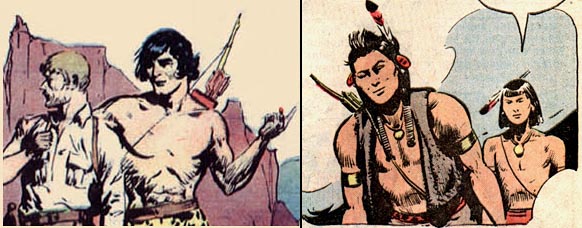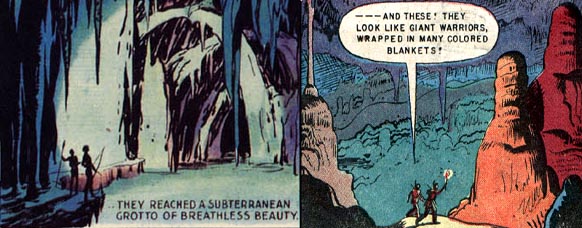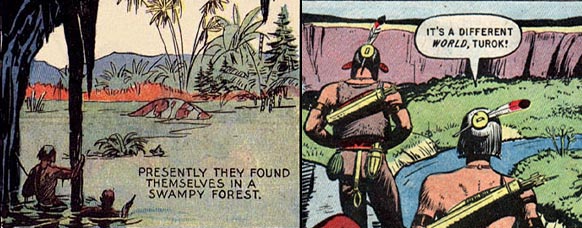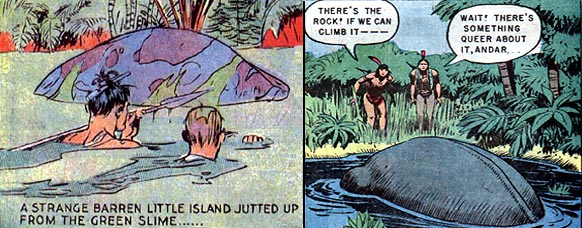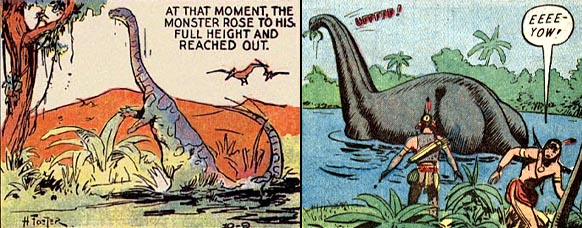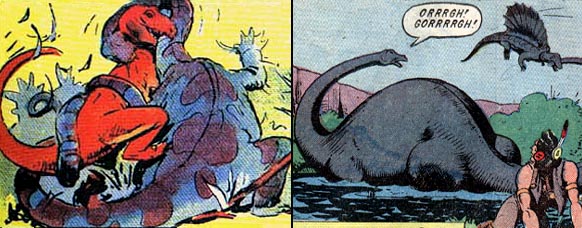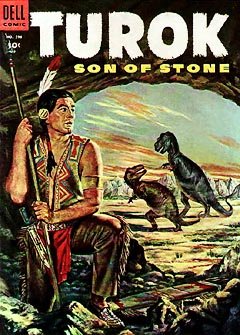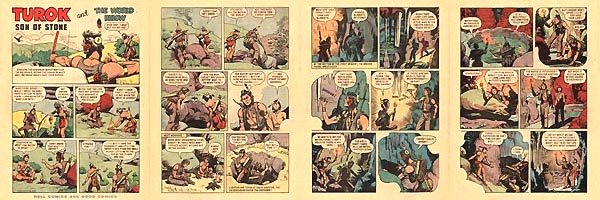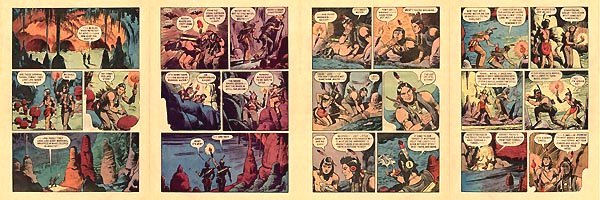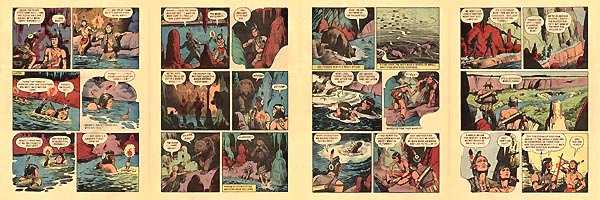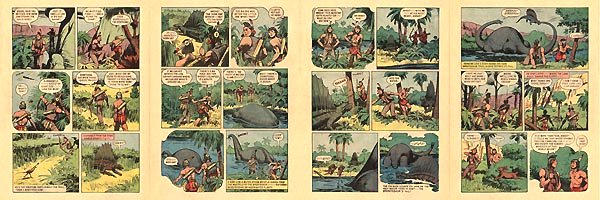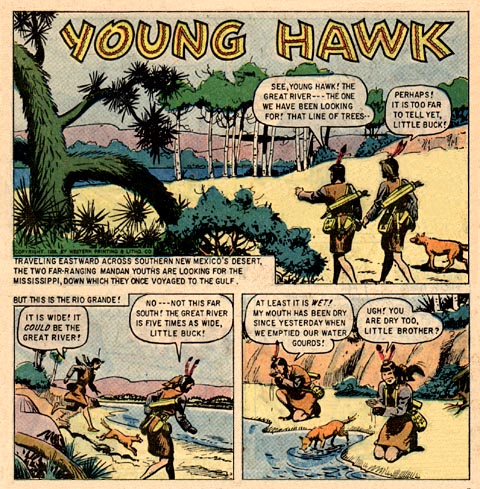Rex
Maxon and Turok Son of Stone
by Dale Broadhurst
Rex Maxon was almost certainly the co-creator of Turok.
He evidently shared the first scripting work with comics professionals
like Dell's editor, Matthew H. Murphy and Whitman's Paul S. Newman, but
the characters Turok and Andar are direct parallels of the Young Hawk and
Little Buck that Maxon drew for Dell's Lone Ranger comicbook throughout
the 1950s.
Not only do Turok and Andar talk and interact very much
like Young Hawk and Little Buck, but both sets of characters are brave,
young plains Indians, living before the introduction of the horse in North
America. Young Hawk and Little Buck are Mandan Indians, while Turok seems
to be a Kiowa (or perhaps a Kiowa-Apache).
In the Aug.-Sept. 1958 issue of the Lone Ranger comic,
there is a Young Hawk story in which the Mandans are walking through what
later became New Mexico. In the following two episode, the braves take
refuge in a great limestone cave (perhaps Carlsbad Caverns). The plotting
of these sequences, all drawn by Maxon, is much like the story told in
the first few panels of Maxon's Turok origin story. The 1958 Young Hawk
episodes were published four years after the first Turok appearance, but
earlier Young Hawk episodes contain similar tales which also parallel the
some of the adventures of Turok and Andar. Young Hawk, in turn, was an
evolution of Maxon's original Indian strip for the Lone Ranger comic: the
Small Bear stories.
In the first story, Turok and his companion Andar venture
into the "Lost Valley" of "the honkers," a strange, tropical world of the
past. Their entrance into this lost world, through a vast limestone cave
system, immediately calls to mind the
1932 (Hal Foster) story of Tarzan and Erik Von Harben, wandering through
a similar underground maze, to the "primeval swamp" where dinosaurs still
dwell upon the earth.
Artist Maxon no doubt savored this opportunity to tell
once again the old United Features Sunday strip story, (which he himself
would have drawn, had his position not been taken over by Harold Foster
just a few months before). For years Rex Maxon's work on the Tarzan strip
had been unfavorably compared with Foster's drawings and Maxon must have
been well aware of that criticism. In laying out the first Turok story,
Maxon had an opportunity to show how he might have illustrated the 1932
Tarzan pages, had he been retained on that challenging job twenty years
before he went to work for Dell.
To his credit, Rex Maxon nowhere copies Foster's famous
panels. The closest he comes to "swiping" from the master, is on page 14
of the origin sequence, where he shows the hump of the sauropod sticking
out of the swamp water. The view is almost identical to what Foster delineated
in 1932, but the remainder of Maxon's story is all an original demonstration
of his own considerable talents.
Rex Maxon's work never contained the stylistic flair and
intricate details that Foster brought to the comics page, but Maxon still
managed to tell a visual story with a good understanding of what the reader
needs to see. He is economical with his brushwork, rarely drawing much
more than the minimum required to move the story along at a rapid pace.
Maxon uses all the same tricks of camera angles, close-ups, distance shots,
and strip "cinematography" that made artists like Foster and Caniff so
well respected, but he does that in a low-key, unobtrustive sort of way.
The reader does not stop to admire Maxon's draftmanship or his backgrounds,
or his panel details in the same way that one might dwell upon a Foster
scene for several seconds. Rather, the reader's eye moves from one Maxon
panel to the next with an easy comprehension of the visual transitions.
There is enough activity in a Maxon page to keep the story from becoming
boring, but rarely does the reader see there the dramatic movements of
a Foster or the frantic activity of a Hogarth.
Hal Foster's 1932 Tarzan panels would have been out of
place in a Dell comic of the 1950s -- they are too colorful, too lush,
too full of embellishment for the Eisenhower Era boys and girls, who knew
that "Dell Comics" were "Good Comics" -- intriguing, easy to read, and
full of clean fun. Maxon was in his element there -- in an environment
where Foster would have been just "too much." Although their strip presentations
were rather different, Rex Maxon's work at Dell was much like that of Jesse
Marsh, in its simplicity and its story-telling. Both served as precursors
to the Russ Manning style of drawing (and Manning was being a bit unfair
when he faulted Maxon for spreading too much black ink through his 1930s
Tarzan daily panels).
And, besides all of that, Foster's scarry, long-toothed
dinosaurs would have been just a bit too much for Dell during the mid-50s.
It was a time when "monster comics" were dying in a mass extinction and
the editorial fingers at Dell must have been crossed when the company decided
to bring out a "funny book" full of man-eating dinosaurs, without so much
as a single Comics Code seal of approval gracing the cover of Turok's magazine.
Turok was a success; it lasted far beyond the time of Mr. Maxon and later
saw a rebirth as a somewhat modified "dinosaur hunter" epic during the
1990s.
On the other hand, a quick perusal of Maxon's Turok pages
is probably enough for anybody to concur that it was best that he left
the Tarzan Sunday stories to Foster and Hogarth. These artists benefitted
from his path-breaking on the Tarzan page, but they then took the feature
to new and breathtaking levels of visual excellence that were something
other than simple Maxonish story-telling. And comparisons -- well, sooner
or later they become odious. Apples and oranges, in this case. And, like
apples and oranges, the Maxons and the Fosters of the comics world each
have their place -- and each deserve to be savored for their own, special
fulness and flavor.

